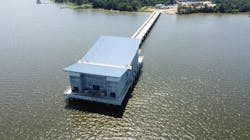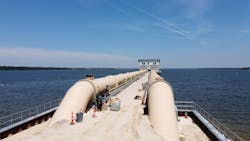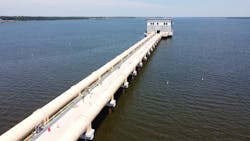Groundwater is the primary source for drinking water in south Texas, but over the years, extensive drafts from aquifers have depleted reserves and caused subsidence, making the Houston-Galveston region one of the largest subsidence areas in the United States.
The consequences of subsidence in Texas are significant. It compromises the ability to store water in aquifers and jeopardizes the integrity of roads, bridges, and building foundations. Subsidence also exacerbates regional flooding in this flood-prone area, where heavy, seasonal rain associated with hurricanes and tropical storms is common.
The Surface Water Supply Project (SWSP) was created in the 2000s by the West Harris County Regional Water Authority (WHCRWA) and the North Fort Bend Water Authority (NFBWA) to manage this critical situation. The SWSP is working to replace groundwater with lake and river water to reduce groundwater usage by 80 percent by 2035.
When the project reaches fruition, surface water from Lake Houston will be supplied to retail water providers in the WHCRWA and NFBWA by way of the City of Houston’s Northeast Water Purification Plant (NEWPP) through more than 55 miles of transmission main and two large pump stations.
The overall NEWPP Expansion Project is a collaboration between the City of Houston, North Harris County Regional Water Authority, WHCRWA, NFBWA and Central Harris County Regional Water Authority. The Houston Waterworks Team (HWT), a joint venture of Jacobs and CDM Smith, is the design-build contractor responsible for design and construction of the project. At $1.77 billion, it is one of the biggest drinking water projects in the world and the largest progressive design-build project of its kind in the United States.
Laying out the Solution
The Luce Bayou Interbasin Transfer Project (LBITP), a recently completed component of the SWSP, is essential to the overall surface water delivery program. The LBITP will move up to 500 million gallons per day (MGD) of untreated surface water from the Trinity River through 23 miles of pipelines and open canals to an outfall structure at Lake Houston for eventual treatment at the NEWPP.
A new Intake Pump Station (IPS), built 1,000 feet from the shore in Lake Houston, will withdraw raw water from the lake and pump it to a newly constructed plant 1.5 miles away for treatment. The IPS is built on a driven pile-supported platform and is outfitted with six, 67.2 MGD pumps (expandable to 10 pumps) that withdraw raw water from the lake and pump it into two, 108-inch transmission mains that carry the raw water over the lake to shore.
The IPS includes underwater fish screens, pumping, and conveyance systems. Treated water will leave the NEWPP Expansion facilities to be transported across the greater Houston area, providing some 3 million people with drinking water.
Planning Addresses Process Challenges
Lake Houston is shallow and lies in an area where flooding is prevalent, which presented challenges for the engineers who designed the IPS and the water treatment facilities. The raw water is flashy, meaning its characteristics are subject to rapid changes. During intense, heavy rains, floodwaters alter the composition of the lake’s water, impacting alkalinity levels and the volume of organic material in the lake. This situation can be exacerbated by local stormwater runoff into the vicinity of the IPS from sources like Jack’s Ditch, a local drainage canal that discharges near the existing pump station.
Randy Rogers, Chief Engineer at HWT and a senior vice president of CDM Smith called this the most challenging water he has ever treated in his long career, noting that during heavy rain events, the lake can be completely flushed as many as 12 times per day, with each instance resulting in changes to turbidity, pH, alkalinity and organic levels. The new IPS is designed to withdraw raw water from a slightly greater depth than the original pump station to help reduce the impact of local stormwater discharges from canals — but this measure only provides part of the solution.
New facilities for coagulation, flocculation and sedimentation at the main plant site will process the raw water to remove inert solids and about half of the total organic carbon content via plate settlers. In the next step, ozone will be diffused into the clarified water for primary disinfection and to oxidize taste and odor-causing compounds. The ozone will also further break down residual organic matter so it can be more readily assimilated by biologically active filters downstream. This is the first time that an ozonation process will be used in Houston.
Tackling Construction
Following a series of competitive procurements for each facility, HWT subcontracted construction work on the IPS to McCarthy Building Companies Inc. and the pump supply to ITT Goulds.
HWT required judicious component selection: the team had to be sure performance would not be compromised when the pumps were started, and the team had to ensure the integrity of the transmission mains through day-to-day expansion and contraction.
To contend with the axial movement experienced by the transmission mains, HWT used nine Victaulic Style 231 Non-Restrained Flexible Expansion Couplings on each of the 108-inch carbon steel raw water transmission mains. The couplings are fixed on one side and have a shoulder on the other side that allows the pipe to slide in and out of the coupling to expand and contract as much as 2 inches to accommodate longitudinal elongation and compression. Two additional couplings, Style 232 Restrained Flexible Couplings, provided reliable joint connections that delivered the necessary flexibility and thrust restraint along the transmission main length.
HWT’s design included bolted split sleeve couplings that could be installed easily within the small footprint of the IPS platform. Simplified installation saved significant time and made it easier and safer for HWT’s subcontractor staff, who were working over a body of water while installing the couplings on the large-diameter mains.
Constructing a new pump station on a driven pile-supported platform far from shore presented many challenges. Steel pilings to support structures had to be driven into the lakebed from equipment on a barge. The IPS was built on a concrete platform and a 1,000-foot-long bridge was constructed to connect it to the shore. Exiting from inside the IPS and running along the top of the sides of the bridge are two 108-inch diameter raw water transmission mains, which are the start of the 1.5-mile-long conveyance system to the main plant site.
In carrying out its portion of the project, McCarthy employed many creative solutions, such as floating the submersible pump cans under the deck of the IPS using inflatable bags. Once the pump cans were at the platform, the inflatable bags were deflated while divers, using winches on embedments cast into the deck above, moved the cans into position. This creative solution allowed construction to progress alongside other work being carried out on the platform.
Installation conditions also posed worker safety challenges. Additional training and special personal protective equipment were required for crews who were working over water, and because the NEWPP Expansion Project was ongoing during the pandemic, extra precautions were taken to avoid unnecessary personnel interaction. Onsite training addressed specific field conditions and project managers ensured that workers followed CDC guidelines for personal protection. This focus on safety paid off for workers, with the project recently reaching a milestone of 5 million hours with zero lost time incidents.
In the face of multiple challenges, HWT and its partners paired ingenuity and practical solutions to implement an effective water treatment program. The complex construction project will ensure a safe and reliable source of drinking water for more than 3 million residents in the Greater Houston area for decades to come. WW
About the Authors: Steven Gabriel is a global construction professional with more than 15 years of experience in project execution and collaborative delivery in the water/wastewater sector. He is currently a divisional manager for infrastructure at Victaulic.
Paul Vranesic, P.E., is the project director for Houston Waterworks Team (HWT). He has more than 30 years of experience in large project, program, and construction management, with expertise managing projects of capital costs exceeding $1 billion.
Published in WaterWorld magazine, November 2021.





